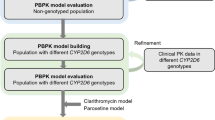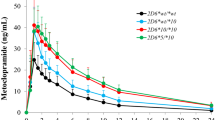Abstract
Background and Objective: The proton pump inhibitor dexlansoprazole is a modified-release formulation of dexlansoprazole, an enantiomer of lansoprazole, which employs a Dual Delayed Release™ (DDR) delivery system. This study was conducted in healthy subjects to assess the absorption, distribution, metabolism and excretion of a 60mg dose of [14C]dexlansoprazole.
Methods: After multiple daily doses of dexlansoprazole DDR for 4 days followed by a single dose of [14C]dexlansoprazole on day 5, absorption, distribution, metabolism and elimination of [14C]dexlansoprazole were assessed in six healthy male subjects whose CYP (cytochrome P450) 2C19 metabolizer status was also determined.
Results: Five subjects were phenotyped as extensive metabolizers (EMs) and one subject was a poor metabolizer (PM). Recovery of radioactivity in urine and faeces averaged 98% after 7 days (51% in urine and 48% in faeces) post-14C dosing. In plasma, dexlansoprazole was the largest component detected, with the main metabolites in the EM subjects being 5-glucuronyloxy dexlansoprazole and 5-hydroxy dexlansoprazole (CYP2C19 mediated), whereas the PM subject had greater amounts of dexlansoprazole sulfone (CYP3A mediated). Dexlansoprazole was not detected in urine; six metabolites were identified accounting for an average of 86% of the urinary radioactivity, with 5-glucuronyloxy dexlansoprazole, 5-glucuronyloxy dexlansoprazole sulfide, 2-S-N-acetylcysteinyl benzimidazole and 5-sulfonyloxy dexlansoprazole sulfide being the primary metabolites. In faeces, parent drug and six identified metabolites accounted for 23% and 72%, respectively, of the faecal radioactivity, with 5-hydroxy dexlansoprazole sulfide and dexlansoprazole sulfide being predominant.
Conclusion: Overall, the results indicate that [14C]dexlansoprazole was well absorbed and extensively metabolized by oxidation, reduction and conjugation to 13 identified metabolites.








Similar content being viewed by others
References
Dexilant™ (dexlansoprazole MR): US prescribing information. Deerfield (IL): Takeda Pharmaceuticals, 2011
Vakily M, Zhang W, Wu J, et al. Pharmacokinetics and pharmacodynamics of a known active PPI with a novel Dual Delayed Release technology, dexlansoprazole MR: a combined analysis of randomized controlled clinical trials. Curr Med Res Opin 2009 Mar; 25(3): 627–38
Metz DC, Vakily M, Dixit T, et al. Review article: dual delayed release formulation of dexlansoprazole MR, a novel approach to overcome the limitations of conventional single release proton pump inhibitor therapy. Aliment Pharmacol Ther 2009 May 1; 29(9): 928–37
Blume H, Donath F, Warnke A, et al. Pharmacokinetic drug interaction profiles of proton pump inhibitors. Drug Saf 2006; 29(9): 769–84
Data on file. Covance 6764-375. Distribution, metabolism, and excretion of 14C-dexlansoprazole following oral administration to rats. Covance Laboratories Inc. 16 February 2007; TAP-07-000396
Dataon file. Covance 6764-374. Pharmacokinetics, absorption, metabolism, and excretion of 14C-dexlansoprazole following oral administration to intact and bile duct-cannulated dogs. Covance Laboratories Inc. 30 March 2007; TAP-07-002721
Rogers JF, Nafziger AN, Bertino Jr JS. Pharmacogenetics affects dosing, efficacy, and toxicity of cytochrome P450-metabolized drugs. Am J Med 2002 Dec 15; 113(9): 746–50
Eichelbaum M, Ingelman-Sundberg M, Evans WE. Pharmacogenomics and individualized drug therapy. Annu Rev Med 2006 Feb; 57: 119–37
Shi S, Klotz U. Proton pump inhibitors: an update of their clinical use and pharmacokinetics. Eur J Clin Pharmacol 2008 Oct; 64(10): 935–51
Kim KA, Shon JH, Park JY, et al. Enantioselective disposition of lansoprazole in extensive and poor metabolizers of CYP2C19. Clin Pharmacol Ther 2002 Jul; 72(1): 90–9
Delhotal-Landes B, Cournot A, Vermerie N, et al. The effect of food and antacids on lansoprazole absorption and disposition. Eur J Drug Metab Pharmacokinet 1991; Spec. No. 3: 315-20
Data on file. Covance 6764-376. Dosimetry calculations for 14C dexlansoprazole based on tissue concentration data following a single oral administration to rats. Covance Laboratories Inc. 13 September 2006; TAP-06-002356
Litalien C, Theoret Y, Faure C. Pharmacokinetics of proton pump inhibitors in children. Clin Pharmacokinet 2005; 44(5): 441–66
Banerjee R, Reddy DN, Rao GV, et al. Oral buffered esomeprazole (BE) in twice daily doses maintain a sustained pH >6 in patients with acute non variceal bleeding (ANVB) after endotherapy: a clinical trial with continuous intragastric pH monitoring [abstract]. Gastroenterology 2007; 132 (4 Suppl. 2): Abstract #213
Sharma VK, Peyton B, Spears T, et al. Oral pharmacokinetics of omeprazole and lansoprazole after single and repeated doses as intact capsules or as suspensions in sodium bicarbonate. Aliment Pharmacol Ther 2000 Jul; 14(7): 887–92
Lee RD, Mulford D, Wu J, et al. The effect of time-of-day dosing on the pharmacokinetics and pharmacodynamics of dexlansoprazole MR — evidence for dosing flexibility with a Dual Delayed Release proton pump inhibitor. Aliment Pharmacol Ther 2010 May; 31(9): 1001–11
Katsuki H, Yagi H, Arimori K, et al. Determination of R(+)-and S(-)-lansoprazole using chiral stationary-phase liquid chromatography and their enantioselective pharmacokinetics in humans. Pharm Res 1996 April; 13(4): 611–5
Pearce RE, Rodrigues AD, Goldstein JA, et al. Identification of the human P450 enzymes involved in lansoprazole metabolism. J Pharmacol Exp Ther 1996 May; 277(2): 805–16
Acknowledgements
This study (T-P106-141) was presented at the 15th biennial meeting of the International Society for the Study of Xenobiotics-North America 2008, San Diego, CA, USA. The authors would like to thank John Brackett, PhD, of Takeda Global Research & Development Center, Inc, for formulation development of the radiolabelled dexlansoprazole in Maalox®. This study was sponsored by Takeda Global Research & Development Center, Inc, Deerfield, IL, USA. The study was conducted by TAP Pharmaceutical Products, Inc, which is now a part of Takeda Global Research & Development Center, Inc. The study sponsor was involved in the design and conduct of the study and collection and management of the data. Ronald Lee is an employee of Takeda Global Research & Development Center, Inc, and Brian Grabowski was an employee of Takeda Global Research & Development Center, Inc, at the time the study was conducted. Both authors were involved in the design of the study, analysis and interpretation of the data, and the preparation, review and approval of this manuscript. Assistance in manuscript preparation was provided by Meryl Gersh, PhD, of AlphaBioCom, LLC, King of Prussia, PA, and funded by Takeda Pharmeceuticals USA, Inc.
Author information
Authors and Affiliations
Corresponding author
Rights and permissions
About this article
Cite this article
Grabowski, B., Lee, R.D. Absorption, Distribution, Metabolism and Excretion of [14C]Dexlansoprazole in Healthy Male Subjects. Clin Drug Investig 32, 319–332 (2012). https://doi.org/10.2165/11630930-000000000-00000
Published:
Issue Date:
DOI: https://doi.org/10.2165/11630930-000000000-00000




